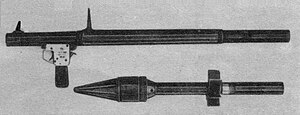RPG-2
| RPG-2 | |
|---|---|
 RPG-2 antitank grenade launcher with PG-2 grenade | |
| Type | Rocket propelled grenade |
| Place of origin | |
| Service history | |
| In service | 1949 - 1960 |
| Used by | See Users |
| Wars | Vietnam War, Cambodian Civil War, Cambodian-Vietnamese War, 2008 Cambodian-Thai stand-off |
| Production history | |
| Manufacturer | State Factories |
| Variants | P-27 Pancerovka (Czech Republic) M57(Federal Republic of Yugoslavia) B-40 and B-50 (Vietnam), (Cambodia) PG-7 (Egypt) Type 56 RPG (China) |
| Specifications | |
| Mass | Template:Kg to lb (unarmed) Template:Kg to lb (ready to fire) |
| Length | Template:Mm to in |
| Crew | 2 including: Grenadier (carries the launcher with three grenades in special backpack) His assistant (armed with assault rifle and carries three more grenades) |
| Shell | PG-2 HEAT round (with RCL-type launch) |
| Caliber | 40 mm barrel 82mm warhead |
| Rate of fire | 3 - 4 rounds per minute |
| Effective firing range | 100 - 150 m |
| Maximum firing range | 199.95 m |
The RPG-2 was the first rocket-propelled grenade launcher designed in the Soviet Union.
Development
The RPG-2 (Russian: РПГ-2, Ручной противотанковый гранатомёт, Ruchnoy Protivotankovy Granatomyot), was a man-portable, shoulder-launched rocket propelled grenade anti-armor weapon. The chief attributes of the RPG-2 were robustness, simplicity, and low cost. However its short range and inaccuracy led to its eventual replacement by the more effective RPG-7. Widely distributed to allies of the Soviet Union, it was also produced under license by other countries, including China and North Vietnam. Widely used against the U.S. military in the Vietnam War, its Vietnamese variants were called the B-40 and B-50.
The RPG-2 design is based on the German Panzerfaust anti-tank weapon developed during World War II.
Developed in 1947 and first delivered to the Soviet Army in 1949, the RPG-2 was deployed at a squad level. Although the RPG-2 could be operated by one man, standard military practice called for a two-man crew: a grenadier carrying the launcher and a purpose-built backpack containing three grenades and an assistant armed with a rifle and carrying another three-grenade backpack.
Description
The RPG-2 rocket launcher is a simple 40 millimeter steel tube into which the PG-2 82 mm diameter rocket propelled grenade is fitted. The center section of the tube has a thin wooden covering to protect the user from the heat generated by a rocket launch. The wooden covering also makes using the weapon in extreme cold conditions easier.

The total length of the weapon with a grenade fitted was 120 centimeters (47 inches) and it weighed 4.48 kilograms (9.8 pounds). Only a simple iron sight was provided for aiming.
Only one type of grenade, the PG-2 HEAT (High Explosive Anti-Tank), was used in the RPG-2. The propellant was in a cardboard case that had to be attached to the grenade before loading. Once attached to the propellant charge the grenade was inserted into the smooth-bore launcher from the front.

To fire the RPG-2 the grenadier cocked an external hammer with his thumb, aimed, and pulled the trigger to fire. Upon launch six stabilizer fins unfolded from the grenade.
The weapon was accurate against stationary targets only up to 150 meters and against moving targets at ranges of less than 100 meters. It had a muzzle velocity of 84 meters per second and could penetrate armor of up to 180 millimeters (7.17 inches) in thickness.
Users
 Cambodia
Cambodia China
China Czech Republic
Czech Republic Egypt
Egypt Laos
Laos Libya
Libya Macedonia
Macedonia Poland
Poland- Moro National Liberation Front[1]
 Soviet Union
Soviet Union Thailand: Used in small numbers mainly by Thahan Phran, captured and stolen from the Communist Force in Vietnam war and other from Laos and Cambodia. [2]
Thailand: Used in small numbers mainly by Thahan Phran, captured and stolen from the Communist Force in Vietnam war and other from Laos and Cambodia. [2] Vietnam
Vietnam Yugoslavia
Yugoslavia
See also
- Rocket propelled grenade, which includes a description of tactics and history.
- RPG-7
- RPG-26
- RPG-29
- PG-7VR
- Yasin RPG
- Type 69 RPG
